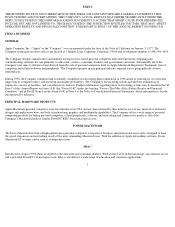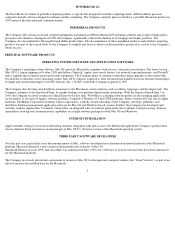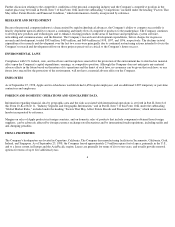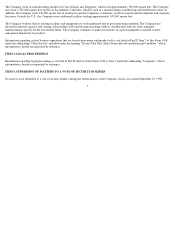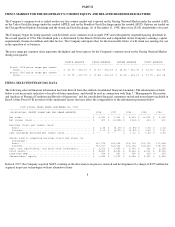Apple 1998 Annual Report Download - page 4
Download and view the complete annual report
Please find page 4 of the 1998 Apple annual report below. You can navigate through the pages in the report by either clicking on the pages listed below, or by using the keyword search tool below to find specific information within the annual report.POWERBOOK G3
The PowerBook G3 family of portable computer products is specifically designed for mobile computing needs. All PowerBook personal
computers include software designed to enhance mobile computing. The Company currently plans to introduce a portable Macintosh product in
1999 aimed at the education and consumer market.
PERIPHERAL PRODUCTS
The Company sells certain associated computer peripherals including LaserWriter-Registered Trademark- printers and a range of high quality,
precision color monitors. During fiscal 1998, the Company significantly reduced the number of its imaging and display products. The
Company also discontinued its MessagePad and eMate product lines. The discontinuance of these peripheral products and portable computing
products was part of the overall effort by the Company to simplify and focus its efforts on those products perceived as critical to the Company's
future success.
PRINCIPAL SOFTWARE PRODUCTS
OPERATING SYSTEM SOFTWARE AND APPLICATION SOFTWARE
The Company's operating system software, Mac OS, provides Macintosh computers with an easy, consistent user interface. The latest version,
Mac OS 8.5, began shipping in October 1998 and delivers Sherlock, Apple's new search feature; fast network copy performance; and PowerPC
native AppleScript for greater speed and system automation. The Company plans to continue to introduce major upgrades to the current Mac
OS and later to introduce a new operating system, Mac OS X, which is expected to offer advanced functionality based on software technologies
of Apple and certain technologies of NeXT Software, Inc. ("NeXT") which the Company acquired in 1997.
The Company also develops and distributes extensions to the Macintosh system software, such as utilities, languages and developer tools. The
Company continues to develop QuickTime, its market-leading cross platform digital media technology. With the launch of QuickTime 3 in
1998, the Company received revenues for QuickTime for the first time. WebObjects, a leading software product in the emerging application
server market, is also part of Apple's software portfolio. Targeted at Windows NT and UNIX platforms, future versions will also run on Apple
hardware. FileMaker Corporation (formerly Claris Corporation), a wholly-owned subsidiary of the Company, develops, publishes, and
distributes database management application software for Mac OS and Windows-based systems. Further, the Company has developed and
currently markets Appleworks 5, formerly Clarisworks, an integrated suite of software applications that combines word processing, database,
spreadsheet, drawing and communications capabilities in a single software package for both Mac OS and Windows.
INTERNET INTEGRATION
Apple's Internet strategy is focused on delivering seamless integration with and access to the Internet throughout the Company's product lines.
An easy Internet Setup Assistant is an integral part of Mac OS 8.5, the latest version of the Macintosh operating system.
THIRD PARTY SOFTWARE DEVELOPERS
Over the past year, particularly since the announcement of iMac, software developers have demonstrated renewed interest in the Macintosh
platform. Microsoft delivered a new version of their productivity software--Office 98:
Macintosh Edition--in early 1998, and since iMac was announced in May 1998 over 1,000 new or revised software titles have been announced
for the Macintosh platform.
The Company previously entered into agreements to license its Mac OS to other personal computer vendors (the "Clone Vendors") as part of an
effort to increase the installed base for the Macintosh
2



